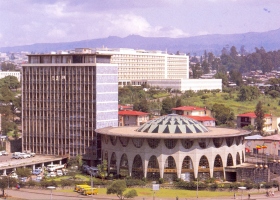ATTRACTIONS IN ADDIS ABABA
There is much to do and much to see in and around Addis Ababa. The following are some from the major attractions.
THE
NATIONAL MUSIUM
Located between Arat Killo, and Sidist Killo, it
comprises of many archaeological and historical findings including the old
skeleton of Lucy, the famous complete hominid fossil remain locally
known as ‘Dinknesh’: the crowns of Emperors, jewelry and costumes
of the country. Visiting this museum is having a good summary for your visit to
the historic Ethiopia.
ETHNOLOGICAL MUSEUM
The institute of Ethiopian studies was established in 1963 with three major components
a research & publication unit, library and museum. The aim of the institute
is to collect document, analyse & disseminate knowledge about languages, cultures
& history of Ethiopia.Ethiopia is cradle of man kind of cross road of culture
& civilization. Ethiopia is also known as "a museum of nationalities".
The museum, therefore, is shouldering a great responsibility of capturing the
heritage of the past & the present. The main focus of the museum is on traditional
art and cultural materials of nationalities. Fortunately enough, the museum is
found in the old palace (Genete Leul means paradise of prince) of the late Emperor
Haile Selassie for this the bed room that is situated on the 1st floor reminds
us once the building was a palace. The reception hall now hosts ethnographic items
of more than eighty ethnic groups. It is divided into two parts. The 1st part
is an introductory part introducing the general picture of socio-economic conditions
of the country. It displays tools of production and some techniques of craftsmen.
The 2nd part is an attempt to provide a quick visit through Ethiopia. Here, some
assorted items from each administrative region are represented. Although the space
in not enough to show the beauty and intensity of the cultural materials of the
country, it creates a strong urge to know more about the country.
THE TRINITY CATHEDRAL
The biggest Orthodox Church in the
country built in 1941 by Emperor Haileselasse in memory of the Ethiopian patriots
who fought against Italians.
It is a beautiful church with a baroque style
of European architecture which is unique to both Ethiopia and Africa and is dedicated
to the Holly Trinity. Here you will find scripts of the imperial families, statues
done by a Greek sculpture, Stained glass window paintings from the Old and New
Testament in the Bible and coffins of Emperor Haile Silassie-I; the founder of
the church, and his wife.
In its graveyard Sylvia Pankhurst, the English
Suffragette and subsequently a long-time friend and defender of Ethiopian independence,
is buried among Ethiopian patriots.
ST. GEORGE CHURCH
The church of St. George, one of the main churches of the town: is a very traditionally structured building. Menelik II following his victory over the Italians at the Battle of Adwa built the octagonal church in 1896. St. George the dragon killer was the patron saint of soldiers and it is to him that the church is dedicated. In St. George church the most interesting thing is the artwork of both modern and traditional church painting. On its inner walls are some modern mosaics by the Ethiopian famous Artist Laureate Meter Afework Tekle.
In the church premise, there is a bell tower & in it there is a permanent exhibition. It was established on 29th of April 1990. The exhibits in the museum are varied. They include costumes of spiritual leaders & sacred rulers, crosses of different kinds, religious books and various works of arts & handicrafts. They throw light on the ancient history particularly on cultural trains of the country.


